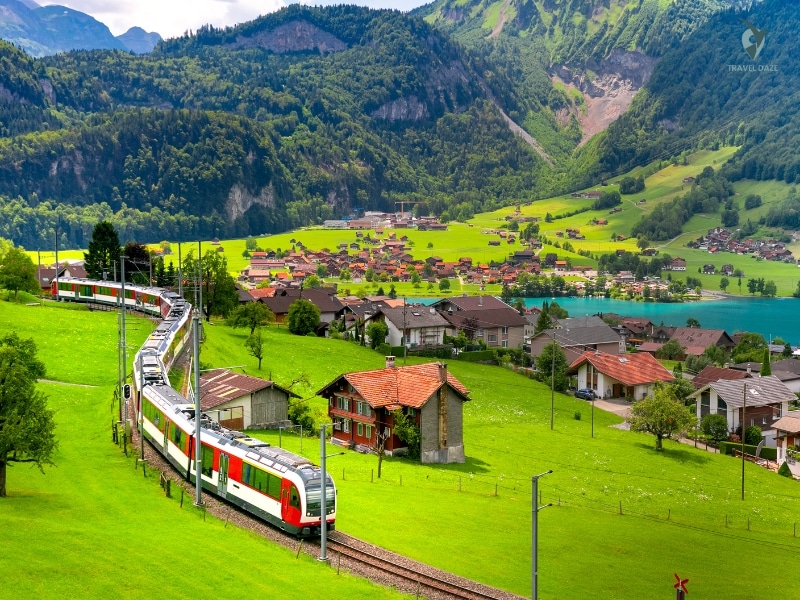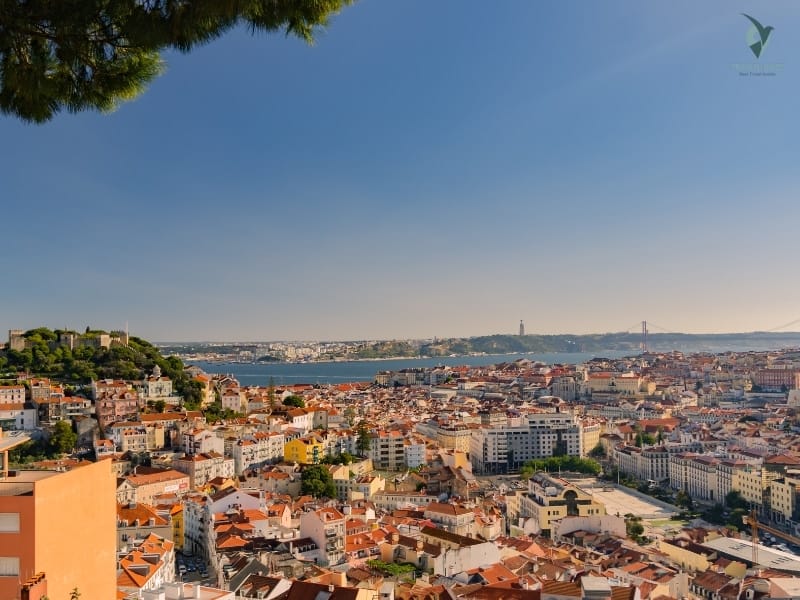The sun cast long shadows across the cobblestone streets as I climbed another steep hill in Lisbon. My legs burned, but the promise of finding another hidden spot kept me going. After three weeks of living like a local in this beautiful city, I discovered something amazing: the real Lisbon lives in its quiet corners, away from the tourist crowds.
Table of Contents
ToggleSure, everyone visits the Belém Tower and takes photos at the famous viewpoints. But the true magic? It’s in the places you won’t find in regular guidebooks. Let me share my favorite secret spots that made me fall completely in love with this city.
1. Jardim do Torel: The Secret Garden with the Best Views of Lisbon
I found this place by accident. Lost in the maze of central Lisbon’s streets, I followed a group of locals up a steep hill. At the top, the Jardim do Torel opened up before me like a hidden paradise. This 19th century garden sits high above the city, offering views that rival any popular tourist spot.
What makes it special? First, the silence. While crowds pack other viewpoints, here I found only a handful of locals reading books or having quiet picnics. The garden has old iron benches painted in fresh white, perfect for watching the sunset over the red roofs of Lisbon.
During summer, they turn the garden’s fountain into a small pool where kids splash around while parents chat in the shade.
Pro tip: Bring some local cheese and wine from the nearby grocery store. The garden has plenty of perfect picnic spots with amazing views of the Tagus River in the distance.

2. Elevador do Lavra: Lisbon’s First Funicular
Everyone knows about the famous yellow trams, but the Elevador do Lavra? This hidden gem became my favorite way to climb Lisbon’s steep hills. Built in 1884, it’s actually the oldest funicular in the city. While tourists crowd onto Tram 28, I often had this historic ride all to myself.
The wooden interior smells like old polish, and the seats still have their original leather. It creaks and groans as it pulls you up the hill, but that’s part of its charm. At the top, you’ll find yourself in a quiet neighborhood with stunning views and local cafes where coffee still costs less than a euro.
3. National Tile Museum: A Ceramic Time Machine
Hidden in an old convent from the 17th century, the National Tile Museum tells Portugal’s story through its famous azulejos (tiles). I almost skipped this place, thinking it would be boring. Wrong! The building itself is worth the visit, with its rich history visible in every corner.
The highlight? A massive 75-foot tile panel showing Lisbon before the great earthquake of 1755. It’s like a time machine. I spent hours spotting buildings that still exist today and others lost to history.
The monastery’s chapel will take your breath away – every inch covered in gold and blue tiles.
Best part? Most tourists don’t make it here because it’s slightly off the usual path. I had entire rooms to myself to admire centuries of artistic history.
4. Jardim da Estrela: The Local’s Living Room
While tourists flock to parks near the center, Jardim da Estrela remains a local secret. This Victorian-style garden feels like stepping into a different world. Exotic trees provide shade over winding paths, and peacocks strut around like they own the place (they kind of do).
I found myself coming here almost daily during my stay. In the morning, elderly locals practice tai chi near the duck pond. By afternoon, young parents watch their kids play while artists sketch in their notebooks. The park has a small cafe with amazing pastries and coffee that costs half what you’d pay in tourist areas.
The wrought-iron gazebo often hosts free concerts on weekends. I caught a jazz band playing one Sunday afternoon – one of those perfect travel moments you can’t plan.

5. Campo de Ourique: The Real Lisbon Neighborhood
Want to experience how locals really live? Skip the touristy Alfama and head to Campo de Ourique. This residential area shows you the authentic side of Lisbon life. The local market here puts the famous Time Out Market to shame – better prices, better food, real locals.
I discovered my favorite pastelaria (pastry shop) here, where the owner remembered my order after just two visits. The neighborhood has amazing street art that nobody photographs, quiet squares where old men play cards, and family-run restaurants where lunch still includes wine, coffee, and dessert for under 10 euros.
Don’t miss the tiny paper shop that’s been around since the 1930s, or the vintage tram depot where you can see old carriages being restored.
6. Parque das Nações: Modern Lisbon’s Hidden Side
Everyone thinks of Lisbon as just historic buildings and traditional charm. But Parque das Nações shows a completely different side of the city. This modern area along the Tagus River feels like stepping into the future while still keeping that special Lisbon magic.
The architecture here blows my mind – especially the Oriente Station with its Gothic-meets-modern design. I loved walking along the riverside boardwalk at sunset, watching planes land over the water and locals fishing off the piers. The cable car ride gives you amazing views of the 25 de Abril Bridge and the city skyline.
Pro tip: Visit the local food market on Saturdays. It’s where actual Lisbon residents shop, and the prices are way better than tourist areas. You’ll find fresh produce, delicious pastries, and authentic Portuguese ingredients to take home. After exploring the market, consider heading to Embaixada Creative Retail in Lisbon, a unique shopping experience housed in a stunning 19th-century palace. It’s a perfect spot to discover local artisans, sustainable brands, and one-of-a-kind treasures.
7. The Secret Spots Around Belém Tower
Yes, Belém Tower is super touristy, but hear me out. While everyone crowds around the tower itself, hardly anyone explores the hidden spots nearby. I found a secret path along the river that leads to quiet beaches where locals fish and have picnics. The views of the tower and the 25 de Abril Bridge from here are incredible.
Walk just 10 minutes west of the tower, and you’ll find a tiny maritime museum in an old lighthouse keeper’s house. The old man who runs it shares amazing stories about Lisbon’s seafaring history if you show genuine interest. Plus, there’s a small cafe nearby with the best fish sandwiches I’ve had in Portugal – and not a tourist in sight.

Getting Around These Hidden Spots
These places might seem scattered across Lisbon, but they’re all easily reachable. I used a mix of metro, buses, and lots of walking. Buy a Viva Viagem card and load it with a day pass – it’s way cheaper than single tickets or taxis.
The best way to find these spots? Get lost on purpose. Seriously. Pick a direction and walk. Lisbon rewards curious travelers who venture away from the typical tourist path.
Final Thoughts
These hidden gems in Lisbon showed me a side of the city that most visitors never see. Beyond the famous sites and tourist attractions, there’s a Lisbon that lives, breathes, and evolves. Each of these spots tells a different story about the city – from its rich history to its vibrant present.
Remember, the best discoveries often happen when you put away the map and follow your curiosity. Lisbon has a way of surprising you when you least expect it. That’s what makes it such a special place.
And please, if you visit these spots, help keep them special. Respect the local vibe, speak softly, and maybe don’t share them all over social media. Some places are better kept as sweet secrets.
Frequently Asked Questions About Lisbon’s Hidden Gems
What’s the best time to visit these hidden spots in Lisbon?
Spring (March to May) and fall (September to October) are perfect. The weather is mild, tourist crowds are smaller, and you can explore without the summer heat. I visited in April and found it ideal for walking and photography.
Are these hidden spots safe to visit?
Yes! All these locations are in safe areas of Lisbon. I visited them alone at different times of day and felt completely secure. Just use basic city safety practices like watching your belongings and staying aware of your surroundings.
How do I get to Jardim do Torel?
Take the metro to Marquês de Pombal or Avenida, then walk about 10 minutes. The Lavra Funicular (Elevador do Lavra) can take you up the hill, or you can climb the stairs if you’re feeling energetic.
Is the National Tile Museum worth visiting?
Absolutely! If you have time for just one museum in Lisbon, pick this one. It’s less crowded than other museums, tickets cost less, and it gives you amazing insights into Portuguese culture and history.
Do I need to speak Portuguese to enjoy these spots?
No, but learning a few basic phrases helps. Most locals in Lisbon speak some English, especially younger people. Simple words like “obrigada” (thank you) and “bom dia” (good morning) go a long way.
How much time should I set aside for these hidden gems?
Plan at least 2-3 days to explore these spots without rushing. I’d suggest spreading them out between visits to major attractions. Each location deserves at least 1-2 hours of your time.
Can I visit these places with kids?
Yes! Jardim da Estrela and Parque das Nações are especially great for families. The gardens have playgrounds, and kids love watching the peacocks. The Tile Museum often has family activities too.
What should I bring when visiting these spots?
Wear comfortable walking shoes (Lisbon’s hills are no joke!), bring a water bottle, and pack a camera. For gardens like Jardim do Torel, bring a light picnic blanket and snacks.
Are these places accessible by public transport?
Yes, all these spots are reachable by metro, bus, or a short walk. Buy a daily transport pass (Viva Viagem card) to save money. Some places might require a bit of walking uphill.
What’s the best hidden spot for photography?
For cityscapes, Jardim do Torel offers amazing views without the crowds. The area around Belém Tower has great sunset shots. The Tile Museum has incredible indoor photo opportunities, but check their photography policy first.
Should I book anything in advance?
Most of these hidden gems don’t require advance booking. However, if you want to eat at any restaurants in Campo de Ourique, booking ahead for dinner is smart, especially on weekends.
What’s the dress code for these places?
Casual and comfortable works fine. For the Tile Museum, wear shoes good for walking on tile floors. For gardens and viewpoints, dress for the weather and bring layers as Lisbon’s temperature can change throughout the day.
Are these places expensive to visit?
No! That’s part of their charm. Most gardens are free, the funicular costs just a few euros, and the Tile Museum has reasonable entry fees. Local cafes and restaurants in these areas charge much less than tourist spots.
Can I take food and drinks to the gardens?
Yes, both Jardim do Torel and Jardim da Estrela welcome picnickers. Just clean up after yourself and be respectful of the space. Many locals bring wine and snacks to watch the sunset.








